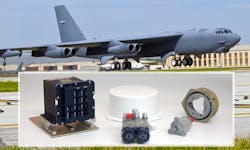Crane to outfit U.S. Air Force B-52H fleet with upgraded antiskid brake control system
BURBANK, Calif., 28 Oct. 2015.Crane Aerospace & Electronics, a segment of Crane Co. (NYSE:CR), won a contract from officials at Tinker Air Force Base to provide an improved Antiskid Brake Control System for the U.S. Air Force’s B-52H Stratofortress aircraft fleet.
The contract award falls under the Air Force B-52 System Improvements project, designed to ensure military aircraft’s viability to perform current and future wartime missions. The project helps to extend the life of the Boeing B-52 Stratofortress, a long-range, subsonic, jet-powered strategic bomber introduced in 1955.
The Antiskid Brake Control Upgrade program is intended to improve brake reliability and performance across the entire B-52H fleet. The Air Force currently operates 76 of the aging long-range bombers.
Crane’s B-52H Antiskid Brake Control system helps prevent aircraft skidding during landings and taxi operations, reducing tire wear and decreasing life cycle costs, officials explain. The new system also enables rapid and timely fault isolation and facilitates streamlined maintenance actions.
“We are extremely proud to provide enhanced brake controls for the U.S. Air Force B-52H fleet,” says Carl Trustee, vice president of landing systems for Crane Aerospace & Electronics.
Crane Aerospace & Electronics delivers systems, components, and power solutions for tough environments, from engines and landing gear to satellites, missiles, and electronic countermeasure devices. Products and services are organized into six integrated solutions for aerospace and defense applications, including Sensing Components & Systems, Fluid Management, Power Components & Subsystems, Landing Gear Systems, Cabin Systems, and Microwave Components & Integrated Systems.
Crane Co. (NYSE: CR) is a diversified manufacturer of highly engineered industrial products. Founded in 1855, Crane employs more than 11,000 people at over 150 locations in 26 countries.
B-52 Technical Specifications
| Primary Function | Heavy bomber |
| Power Plant | 8 Pratt & Whitney engines TF33-P-3/103 turbofan |
| Thrust | Each engine up to 17,000 lbs |
| Wingspan | 185 ft (56.4 m) |
| Length | 159 ft, 4 in (48.5 m) |
| Height | 40 ft, 8 in (12.4 m) |
| Weight | Approximately 185,000 lbs (83,250 kg) |
| Max Takeoff Weight | 488,000 lbs (219,600 kg) |
| Fuel Capacity | 312,197 lbs |
| Payload | 70,000 lbs (31,500 kg) |
| Speed | 650 mph (Mach 0.86) |
| Range | 8,800 mi (7,652 nautical miles) |
| Ceiling | 50,000 ft (15,150 m) |
| Crew | 5 (aircraft commander, pilot, radar navigator, navigator and electronic warfare officer |
| Initial operating capability | May 1961 (Current ‘H’ Model) |
| Armament | Approximately 70,000 lbs (31,500 kg) mixed ordnance -- bombs, smart weapons, mines and missiles. Modified to carry air-launched cruise missiles and Miniature Air Launched Decoy. |

Courtney E. Howard | Chief Editor, Intelligent Aerospace
Courtney enjoys writing about all things high-tech in PennWell’s burgeoning Aerospace and Defense Group, which encompasses Intelligent Aerospace and Military & Aerospace Electronics. She’s also a self-proclaimed social-media maven, mil-aero nerd, and avid avionics and space geek. Connect with Courtney at [email protected], @coho on Twitter, on LinkedIn, and on Google+.


